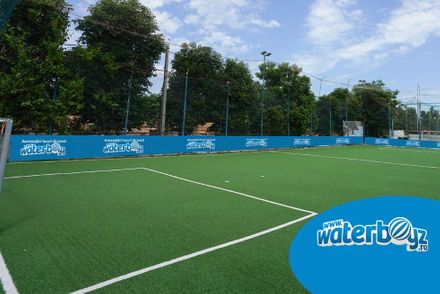Designing a sports field begins with selecting the right space, choosing the perfect surface, and creating an action plan. While planning a sports field installation might seem like a simple task, each field, climate, and sport requires a customized installation approach.
As specialists in sports field design, our approach to developing optimal surfaces starts with clear communication and expert guidance, culminating in an excellent field design that enhances player safety.
Benefits of a Sports Field
Engaging in sports promotes health and brings communities together. If you're passionate about sports and want to start your own business, investing in a sports field is a decision you won't regret. Such an investment can be recouped in 2-3 years, and you can increase revenue by hosting events, using promotions, and seeking sponsorships, thereby shortening the payback period.
Benefits of Local Sports Competitions
Professional sports teams often attract tourists to lesser-known areas, benefiting local businesses. Sporting events can become a city's main attraction, especially when renowned athletes draw attention to charitable causes by raising funds for local schools or hospitals.
Local Economic Impact of New Sports Fields
Building a new sports facility in your city can stimulate the local economy. A new sports complex generates jobs and pays local taxes. Sports fields also serve as gathering spaces for large groups. These facilities boost local revenue when hosting sports teams on tour or organizing musical events, leading to increased earnings.
Sports in Romania
Currently, there are over 310,000 registered athletes in Romania. This number might seem small compared to the whole population, but the actual number of people engaging in sports is much higher.
Even the great legends of Romanian sports played in schoolyards or on improvised fields before joining sports clubs. Imagine the opportunities you can provide to young talents in your community by establishing an international standard sports field. Your football field could launch the next top scorer for the Romanian National Team.
Considerations for Sports Field Design
Having and maintaining a recreational space benefits community health, well-being, and the economy. However, designing a sports field is a complex process. Several factors come into play in creating a state-of-the-art sports complex. Here's what you should consider when designing a sports field:
Sport Activities
Begin by choosing the sports activities. Consider which sports are not yet popular in your area or the age groups you intend to serve.
Surface Selection and Quality
The sports field surface is one of the most important aspects to consider. Think about it: your clients and visitors will spend most of their time here. But how do you choose the right surface? Should you go for artificial turf or poured tartan? Both have numerous benefits, but the choice depends on the type of sport you want to host.
Artificial turf is commonly found on football or tennis fields, while poured tartan is ideal for athletics tracks and fields for football, tennis, volleyball, handball, basketball, or multisport use.
We know that Romanian athletes can perform even in less favorable conditions when it comes to the playing surface. We remember the VIKING - FCSB match played on the northern team's synthetic and worn-out turf, which was meant to be a disadvantage for the Romanians. While FCSB did win under those challenging conditions, the news focused more on the poor quality of the field. So, here's our question: Do you want the news to talk about victories on your field or about the poor quality of the turf?
Optimizing Space
For a large sports facility, dividing spaces for different activities like basketball, volleyball, padel, tennis, and others can be easy. But when the field area is limited, optimizing space becomes harder and might require overlaying smaller fields on larger ones. This way, you can host multiple sports on a single field.
Drainage
As a general rule, water-permeable sports surfaces are suitable for all types of sports fields. Even though you don't need to water synthetic turf, you still need to ensure proper drainage for rainwater and melted snow. Nobody wants to play on a flooded field.
Lighting
The next consideration when setting up a new sports field is lighting. Most new sports fields host night games, which can be a great way to generate more revenue from your investment.
Even if you don't plan on hosting night games, you'll still need lighting for security reasons. Therefore, a low-energy LED lighting system will reduce your energy costs and protect clients from overheating in the hot season.
Types of Sports Fields
Many sports clubs are looking for ways to maintain their fields in excellent condition without the cost and effort of natural grass. The most commonly used and durable materials for sports fields are synthetic turf and poured tartan.
Setting Up a Field with Synthetic Turf
Synthetic turf emerged as an excellent solution that requires minimal maintenance and is appealing to both players and spectators. Because it doesn't need regular mowing or irrigation, football fields or tennis courts with artificial turf can save significant maintenance costs. Synthetic turf is preferred due to easy installation and excellent adaptability to the field surface. However, not all types of artificial turf are suitable for every sport.
Artificial turf for football has a blade length of 50mm and includes a rubber granule substrate for player-surface contact cushioning. On the other hand, turf suitable for tennis courts or basketball has a blade length of only 13mm, offering optimal trajectory and ball bounce. Professionalism is needed to achieve the perfect look. Therefore, Waterboyz expert teams, with years of experience in sports field setup, can provide you with a perfect field in 30-60 days, depending on complexity. The warranty for synthetic turf is 24 months, with a lifespan of 7 to 10 years.
Setting Up a Field with Poured in place Rubber
A weatherproof field! You can find it in schools, universities, sports facilities, recreational clubs, and public spaces. The colored-marked rubberized surface is ideal for outdoor play in any season. The rubber surface absorbs shocks, aids ball bounce, protects athletes from injury, is slip-resistant, and dries quickly after rain.
Depending on accessories and surface size, a poured-in-place rubber sports field is suitable for football, tennis, volleyball, basketball, high and long jumps, and even gymnastics classes. The warranty for poured tartan is 24 months, with an average lifespan of 10 to 12 years.
Setting Up a Multisport Field
A multisport field with synthetic turf is a playing surface that can be used for multiple sports simultaneously. For example, a tennis court can also be used for basketball by marking both courts. This type of field is becoming more popular because it offers great value to the community. Depending on the sports practiced on the field, it can be set up with either synthetic turf or rubber.
The field's dimensions and playing surface vary based on the games played, with larger playing field sports determining the layout:
- For a multisport field catering to football, tennis, and basketball, the required playing area is 42 x 22 m (football field dimensions) with short-blade artificial turf. Different colored markings will outline the tennis (34x17 m) and basketball (28x15 m) courts.
- Alternatively, if you want a field for tennis, volleyball, and basketball, the setup area will be 34x17 m (tennis court dimensions), using poured tartan or short-blade artificial turf. Colored markings within the field will separate the volleyball (18x9 m) and basketball (28x15 m) courts.
The main advantage of a multisport field is its cost-effectiveness; you can save money by using multifunctional fields. Occupancy rates increase, and you won't need to build separate fields for different sports.
Costs of a Sports Field
The cost of setting up a sports field varies based on:
1. Field size:
- football 42x22 m
- handball 42x22 m
- tennis 34x17 m
- basketball 28x15 m
- voleyball 18x9 m
2. Playing surface material:
- 50mm turf
- 13mm turf
- Tartan
3. Type and number of accessories:
- Football or handball goals
- Tennis or volleyball nets
- Basketball backboards
- Protective nets
- Lighting system
Markings
For example, the cost of a 42 x 22 m multisport field with 50mm turf, including 2 mini football goals and protective fencing, starts at 31,000 EUR + VAT (excluding transportation and installation). However, for a smaller surface, a 20x10 m mini football field with 50mm turf, including 2 mini football goals and protective fencing, starts at 10,500 EUR + VAT (excluding transportation and installation).
Why is a Sports Field a Profitable Business?
Investing in a sports field allows you to build a customer base relatively quickly, and the setup costs can be recouped within the first two or three years. Passion for sports can be successfully monetized by renting the field for at least 6 hours a day, 15 days a month, 8 months a year, at 25 Euros per hour. Here's a quick calculation:
Renting the field (6h/day, 15 days/month) brings in a monthly revenue of (25615) 2250 Euros.
Profitability is calculated as the ratio of rental income to field cost, expressed as a percentage. For a 42x22 m multisport field with 50mm turf, priced at 31,000 Euros and rented for 8 months a year at 2250 Euros per month, the profitability is (2250*8 months)/31,000, which is 58%. To determine the investment payback period, we calculate the inverse ratio, dividing the field's cost by the annual income: 31,000/18,000, indicating that it will take less than 2 years to recover the investment.
*This is an approximate calculation and does not include monthly expenses and taxes. Remember that boundary netting can serve as advertising space and generate additional income. Hosting sports competitions will help with promoting your business.
In conclusion, constructing a sports field can bring both financial and professional benefits. Focus on quality, functionality, and Waterboyz's professional services to achieve your desired results.




































































































































